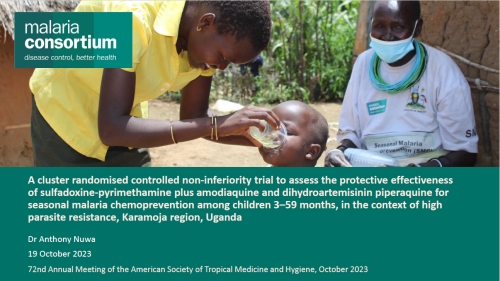
Publication Date:
19/10/2023
Author:
Anthony Nuwa
Type:
Presentation

A cluster randomised controlled non-inferiority trial to assess the protective effectiveness of SPAQ and DP for SMC among children 3–59 months, in the context of high parasite resistance, Karamoja region
Publication Date:19/10/2023
Author:
Anthony Nuwa
Type:
Presentation
Sulfadoxine-pyrimethamine plus amodiaquine (SPAQ) and dihydroartemisinin piperaquine (DP) were both highly effective at preventing clinical malaria in eligible children during the high transmission season in Karamoja region, Uganda.
Malaria is public health problem in Uganda that affects almost 100 percent of the population. The Karamoja region, where malaria transmission is seasonal, consistently reports the highest prevalence rates. The Uganda Malaria Reduction and Elimination Strategic Plan 2021–2025 recommends seasonal malaria chemoprevention (SMC) to accelerate progress towards malaria elimination. Modelling conducted by the Swiss Tropical and Public Health Institute suggests SMC would be effective in preventing malaria in the Karamoja region.
A non-randomised study conducted in 2021 suggested SMC with SPAQ was feasible, acceptable and an effective malaria control strategy in the Karamoja region. There was a need to explore alternative drug regimens due to concerns about widespread resistance to SP. Dihydroartemisinin-piperaquine (DP) is a potential alternative for use in SMC.
This cluster-randomised controlled trial (cRCT) was conducted with the aim of generating further evidence regarding the effectiveness of SMC to inform policy decisions. The target population consisted of 270,000 children 3–59 months, with the majority receiving SPAQ and approximately 15,000 receiving DP. Five SMC cycles were implemented between May and September 2022. Village health teams (VHTs) distributed SMC medicines through a house-to-house approach and were supervised by health facility-based health workers.
This presentation was given at the 72nd annual meeting of the American Society of Tropical Medicine and Hygiene.
Country: Uganda
Keywords: ASTMH | Child survival | Community delivery | Malaria | SDGs | SMC
« Back to Publications